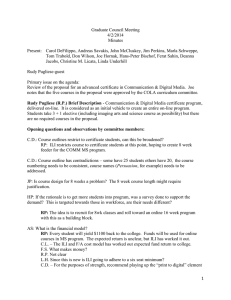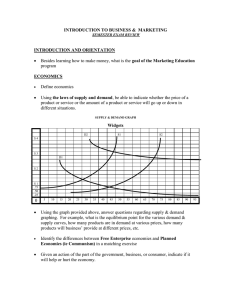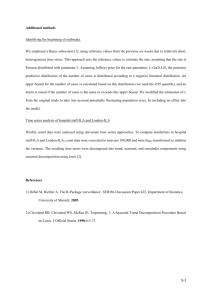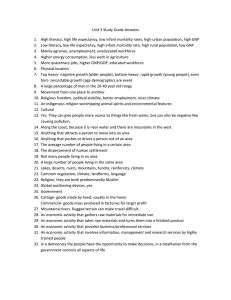“What is Quality of Life? An Indonesian Case Study”
advertisement
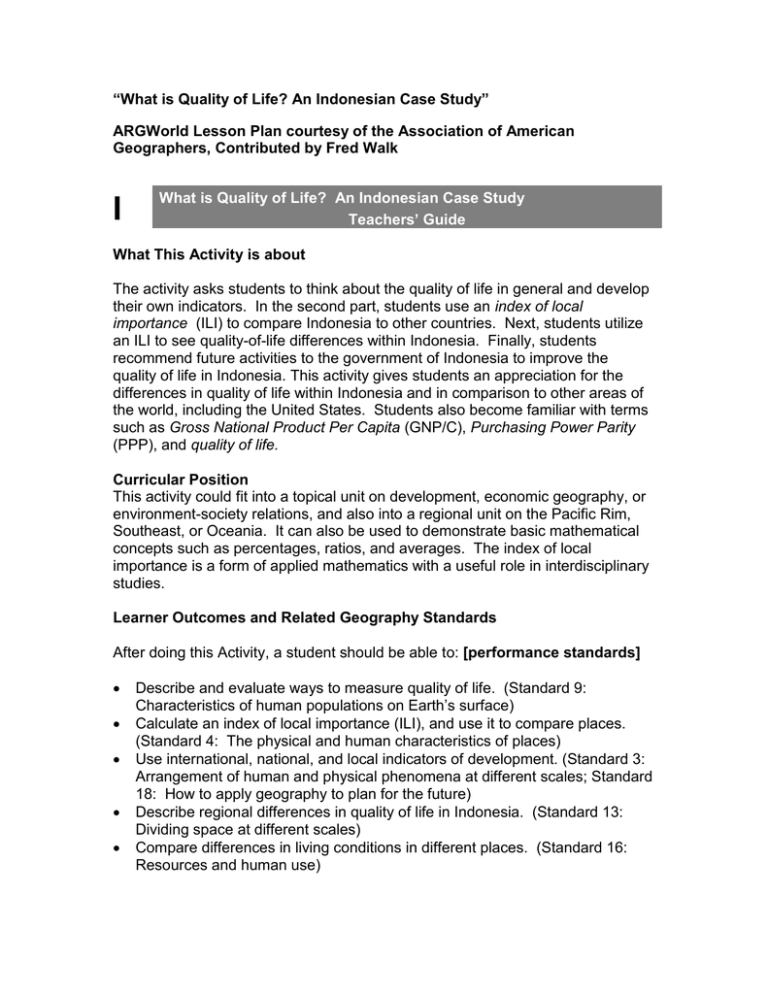
“What is Quality of Life? An Indonesian Case Study” ARGWorld Lesson Plan courtesy of the Association of American Geographers, Contributed by Fred Walk I What is Quality of Life? An Indonesian Case Study Teachers’ Guide What This Activity is about The activity asks students to think about the quality of life in general and develop their own indicators. In the second part, students use an index of local importance (ILI) to compare Indonesia to other countries. Next, students utilize an ILI to see quality-of-life differences within Indonesia. Finally, students recommend future activities to the government of Indonesia to improve the quality of life in Indonesia. This activity gives students an appreciation for the differences in quality of life within Indonesia and in comparison to other areas of the world, including the United States. Students also become familiar with terms such as Gross National Product Per Capita (GNP/C), Purchasing Power Parity (PPP), and quality of life. Curricular Position This activity could fit into a topical unit on development, economic geography, or environment-society relations, and also into a regional unit on the Pacific Rim, Southeast, or Oceania. It can also be used to demonstrate basic mathematical concepts such as percentages, ratios, and averages. The index of local importance is a form of applied mathematics with a useful role in interdisciplinary studies. Learner Outcomes and Related Geography Standards After doing this Activity, a student should be able to: [performance standards] Describe and evaluate ways to measure quality of life. (Standard 9: Characteristics of human populations on Earth’s surface) Calculate an index of local importance (ILI), and use it to compare places. (Standard 4: The physical and human characteristics of places) Use international, national, and local indicators of development. (Standard 3: Arrangement of human and physical phenomena at different scales; Standard 18: How to apply geography to plan for the future) Describe regional differences in quality of life in Indonesia. (Standard 13: Dividing space at different scales) Compare differences in living conditions in different places. (Standard 16: Resources and human use) Discuss the nature of quality of life and how and why it differs from place-toplace. (Standard 11: Patterns and networks of economic interdependence) Evaluations to Test Outcomes Collect students' completed Response Sheets and check them against the Key provided at the end of this Teacher's Guide. Evaluation procedures can be directed towards student ability to convert numerical data into percentages or ratios, how to use data table and calculate an index of local importance or how to describe and evaluate ways to measure quality of life. Requirements Time: Three to four 45-minute class periods. Materials: A copy of the Student Activity, including Response Sheet, for each student. The Response Sheet Key is in this Teacher's Guide. Overhead transparencies OHT1. Definition of an index of local importance OHT2. How does scale relate to you? OHT3. Calculating an index of local importance 1 OHT4. What is our country’s ILI? OHT5. Global averages for selected indicators of quality of life (Table 1) OHT6. World map-selected countries OHT7. Quality of life indicators for selected countries (Table 2) OHT8. Calculating an index of local importance 2 OHT9. Calculating an index of local importance 2 OHT7. Indonesia map of provinces (Fig. 3) OHT8. Quality of life indicators for selected Indonesian provinces (Table 4) Module on CD ROM. Calculators, if available Readings Textbook and readings. Checklist of Classroom Procedures Setting Up the Activity 1. Pose these questions to the class: What does quality of life mean, and do all people enjoy a high quality of life? 2. Have students discuss their daily lives and what makes their lives comfortable (TV, bathrooms, food, cars, houses, etc.). Then encourage them to think about the fact that many people do not have access to these same things. Have students think about what quality of life is for them and how they can measure it. Also, ask them to think about what types of indicators might be useful to measure quality of life, and what types may not be as useful. Alternatives: Use a picture, newspaper headline, and/or world maps and ask questions about how different people use different types of resources to meet their needs. Yet another avenue for introducing this topic is by starting at the local level and introducing the idea of development. Development agencies and practitioners regularly utilize indicators such as GDP, PPP, education, and infant mortality in their work. Getting students to think about the needs of development agencies for standardized indicators can provide a useful avenue for constructing quality of life indexes. Another way of getting started is by providing raw numbers for quality of life indicators to students (such as GDP, GNP, PPP, total deaths, etc.) and asking them to think about the fact that these numbers are not comparable without a ratio expression. For example: Australia has a higher GNP ($382 billion-1997) than Austria ($225 billion-1997). However, dividing this figure by total population (Australia, 19 million-1997; Austria, 8 million-1997) reveals that Austria actually has a higher GNP per capita ($27,000-1997) than Australia ($20,650-1997) (World Bank 1999). Other types of raw data will enable students to think about constructing ratios or indexes that enable them to compare numbers and indicators across categories. Shorter exercises can just complete the initial exercise on constructing ILI’s, then move on to new types of economic or geographic materials. Running the Activity 1. Have students read the Background section in the Student Activity and ask questions to clarify any confusion. Go over the Student Activity with the whole class and be clear about your expectations for completing and handing in the Response Sheet. Either have the class as a whole discuss their answers to the questions at the end of the Background section or have students work in pairs to answer them. In any case, have students write their own answers to questions 1 and 2 on their Response Sheets. (See the Response Sheet Key at the end of this Teacher's Guide). 2. Have students read the Objectives section and clarify their meanings, as needed. 3. Have students read the section, What is an Index of Local Importance? Use transparencies of GNP/C and ILI formulas and examples to help students understand the ideas in this section. Remind students of one basic rule: If a measure’s index of local importance is greater than 1, that measure is more important in the local area (e.g., a country) than it is for the larger average (all countries). An ILI of less than 1 means the measure is less important in the local area than for the larger average. An index of local importance can be computed for almost any measure that can be expressed as a percentage or ratio (e.g., infant deaths per thousand people, school enrollment per thousand people, or percentage of people with access to clean water). 4. Move on to the next section, How does quality of life vary among countries? Ask students to think about their own neighborhoods, cities, or states and how people live very different lives from place to place. The quality of life is likely to differ even between neighborhoods within a town or city. Geographers speak of spatial inequalities (or uneven development ) if, for example, some neighborhoods (or countries) have a higher quality of life than others. Have students work in pairs to complete Table 2 in the Response Sheet. Then, have them answer questions 4-7 in the Response Sheet. 5. Now, direct attention to the section, How does quality of life vary within countries? The case of Indonesia. Have students read the Scenario and Indonesia in brief. Table 4 has quality-of-life data for 8 provinces within Indonesia. Have students highlight those provinces on their map of Indonesia (Fig. 2) in the Response Sheet. Then, have them work in pairs (or larger cooperative groups) to fill in the empty cells of Table 4 in the Response Sheet. 6. Have students work in pairs (or larger cooperative groups) to answer questions 9-13 in the Response Sheet. Concluding the Activity 1. Debrief the activity by directing attention to the need for a team report, as described in question 14 on the Response Sheet. This report can be an individual, pairs, or cooperative group project. 2. Have students share the recommendations in their team reports. Classify the recommendations and compare them in discussion. Progress Checks Be sure students understand averages (or means). You might give them a problem to work out the average for a group of members that have a wide range. This will help them understand that you can have wide extremes within an average. Note that a country’s GNP/C can mask extremes of rich and poor. The new skill involved in this activity is to understand how to construct and interpret an index of local importance (ILIs). An ILI is a comparison of ratios-percentages, income, per capita--rather than raw numbers. This is the main source of confusion; check to make sure students get this point. Another skill is to encourage students to analyze various indicators and how they differ across and within countries at different scales. Make sure students understand that differences among countries are at a global scale of analysis while the differences among Indonesia’s provinces are at a national scale of analysis. Check to see that students understand that differences between neighborhoods are considered to be analysis at a local scale. You could exemplify these ideas about scale with maps at different scales. Redirections A source of many problems in constructing an ILI is to get students to understand the importance of a single national or international average as a source of comparison. Using global or national averages allows an ILI to demonstrate how specific places differ from each other and from the overall average. Try to redirect student attention to this concept if they are confused about the mathematical calculations and their purpose. In addition, arguments about what constitutes quality of life and how to compare various indicators will allow students to place the abstract indicator data in a real setting that makes sense to their individual lives. Remember to emphasize that what constitutes the quality of life is, in the final analysis, subjective: it has no right or wrong answer. Perceptions of quality of life may differ among individuals and may vary from place to place with differences in cultures and societies. Extensions and Enrichment Question #13 on the Response Sheet suggests many things that students can investigate in order to better understand uneven development. This activity can be extended by exploring indicators of development even further, either within Indonesia, in other countries, or among countries. Different types of indicators can also be utilized by students including environmental, social, economic and political indicators (see the sources listed under Additional Information below). Most of the data sources are easily accessible, published annually and contain country-level data. Individual countries also publish information on regional and local indicators. Generally, the World Wide Web is a good source for local and regional indicators. I What is Quality of Life? An Indonesian Case Study Student Activity Background Why are some countries rich and some poor? Why do people in some places enjoy good water, food, housing, clothing, medical facilities, and education, while people in other places suffer without these basics for a decent quality of life? And within countries, why are some regions rich while others are poor? What causes these spatial inequalities, both within and between countries, in the quality of life? In order to improve peoples' daily lives, we need to find answers to these questions. To compare quality-of-life differences among countries, you need some measures. It takes wealth to buy some of the things needed for a high quality of life, such as good food and housing. The most commonly used measure of a country's wealth is Gross National Product Per Capita (GNP/C). Usually, the higher a country's GNP/C, the better its quality of life. GNP/C is the total value of goods and services produced by a country divided by its population. For example, the value of the cereals, minerals, and fish produced by a country's farms, mines, and rivers contribute to its GNP. When its factories produce steel or cars or t-shirts they add to the GNP. And the value of services such as banking, telecommunications, transportation, teaching, and dentistry also count toward a country’s GNP. Because money has different purchasing power in different countries, GNP values are converted to a common value as if there was a common international currency. This is called Purchasing Power Parity (PPP), meaning that all money has the same purchasing power. You can explore differences in the quality of life among countries by comparing PPP GNP/C. For example, in 1997, the United States had a PPP GNP/C of $29,080, while Indonesia had only $3,390. The global average for PPP GNP/C in 1997 was $5,180 (World Bank 1999). You can compare individual countries to the global average to measure, in general terms, whether their quality of life is better or worse than the rest of the world. But other indicators may be equally or even more important, such as life expectancy, literacy, infant mortality, availability of medical services, and sanitary facilities. Do you think that the presence of radios, televisions, VCRs, computers, CD players, and other consumer goods are good quality-of-life indicators? Why or why not? Are some quality-of-life features difficult, if not impossible, to measure? If so, which ones do you suggest? Write your answers to these questions at 1 and 2 on Response Sheet I. Objectives In this activity, you will learn to: Describe and evaluate ways to measure quality of life. Calculate an index of local importance (ILI), and use it to compare places. Use international, national, and local indicators of development. Describe regional differences in quality of life in Indonesia. Compare differences in living conditions in different places. Examine the nature of quality of life and how and why it differs from place-toplace. What is an Index of Local Importance? You learned that PPP GNP/C can tell you whether one country is higher or lower than another country on that measure, but it does not tell you how a country compares to all countries on that measure. To learn that, you can use an Index of Local Importance (ILI). The ILI shows whether an area is typical or unusual compared to all countries on a particular measure. It gives you a good way of comparing measures of the quality of life within and between different countries. The ILI shows how features of a local area compare to a national, regional, or global average. Here's an example of how this works. To compute the ILI, divide the figure in each country by the global average. To return to the United States example, PPP GNP/C for 1997 was $29,080. If you divide this by the global average ($5,180), you get 5.6. This means that the U.S. had 5.6 times the global average PPP GNP/C. Note that if the U.S. figure was the same as the global average, the ILI would be 1. ILIs above 1 are higher than the average and those below 1 are lower than the average. If you divide Indonesia’s 1997 PPP GNP/C ($3,390) by the global average ($5,180), the ILI is about .65, which is much lower than the global average. ILIs are most useful when you want to compare raw figures. For example, in 1994, approximately 77 million Indonesians lived in urban areas, while in the U.S., 203 million people lived in urban areas (United Nations 1998). Because these countries do not have the same population sizes, these raw numbers do not tell you which country is more urbanized. To learn that, you need to change raw numbers to percentages. Figured as a percentage, 37 percent of the people in Indonesia live in urban areas, while 75 percent of the U.S. population is urbanized. But these percentages do not tell you how the countries compare to all countries. To learn this, you need to compute the ILI, as follows: Divide the percentage urbanized in each country by the global average (44 percent of the world's population live in urban areas). In our example, the U.S. had an ILI of 1.7 (75 percent divided by 44 percent). This means that the U.S. percentage of urbanization was 1.7 times higher than the global average. The figure for Indonesia was 37 divided by 44 percent, which gives an ILI of .84, a figure somewhat less than the world's average. How does quality of life vary among countries? To see how quality of life varies among some countries, compute ILIs for the selected indicators of quality of life that are given in Table 1. Table 2 gives the global averages for these indicators. Locate the countries selected in Table 2 using the world map (Figure 1). Complete the missing ILIs for infant mortality, safe drinking water, and TVs in Table 2 on Response Sheet I-1. Table 1: Quality of Life Indicators for Selected Countries NIGERIA 102 SENEGAL 15 POPULATION (MILLIONS) 118 9 PPP GNP PER CAPITA ($) 864 PPP GNP ILI 0.17 PPP GNP ($BILLIONS) INFANT MORTALITY INFANT MORTALITY ILI % OF POP. WITH ACCESS TO SAFE WATER SAFE WATER ILI TELEVISIONS TELEVISIONS ILI PERU 112 ARGENTINA 360 FRANCE 1301 U.S. 7,783 INDONESIA 679 24 36 59 268 200 1,667 4,667 10,000 22,051 29,041 3,395 0.32 0.90 1.9 4.3 5.6 0.66 77 70 52 24 6 9 60 _____ _____ _____ _____ _____ _____ _____ 50 50 66 65 100 73 65 _____ _____ _____ _____ _____ _____ _____ 4 4 10 32 58 78 15 _____ _____ _____ _____ _____ _____ _____ Sources: United Nations 1998; World Bank 1999. Table 2: Global Averages for Selected Indicators of Quality of Life Indicator Global Average PPP GNP per capita (1997) $5,180 Infant Mortality (1995) Deaths under age 1 per 1,000 live births 57 Percentage of Population with Access to Safe Drinking Water 75 Number of Televisions (per 100 people) 22 Sources: United Nations 1998; World Bank 1999. Calculating the Index of Local Importance: Example 1: Nigeria-PPP GNP per capita 1) PPP GNP $102,000,000,000 PPP GNP per capita $864 Population 118,000,000 2) Nigeria PPP GNP $864 ILI of .17 Global PPP GNP $5,180 Example 2: Nigeria-Infant Mortality 1) Infant Mortality (Nigeria) 77 ILI of 1.35 Infant Mortality (Global Average) 57 Answer questions 4-7 on Response Sheet I-2. 4. In Table 1, which country has the largest ILI, and for which indicator? What does this signify? 5. In Table 1, which country has the lowest ILI, and for which indicator? What does this signify? 6. Which countries in Table 1 have the highest quality of life? Why? Make a case for the one country you think has the highest quality of life. 7. Which countries in Table 2 have the lowest quality of life? Why? Make a case for the one country you think has the lowest quality of life. How does quality of life vary within countries? How does this apply in the case of Indonesia? In this part of the activity you can further explore ILIs to learn about the quality of life in Indonesia. Consider the following scenario. Scenario Imagine that you are a member of a United Nations Development Program (UNDP) team. The Indonesian government has asked your team to make recommendations for improving the quality of life in Indonesia. Your team decides that its first job is to find out how quality of life varies within the country. You decide to use Indonesian government data to make an index of local importance that measures the quality of life among the country's provinces. Figure 2: Map of Indonesia Indonesia in brief With over 200 million people, Indonesia is the fifth most populous country in the world. It is made up of more than 17,000 islands, more than 6,000 of which are uninhabited. The country stretches for more than 3,000 miles from west to east and over 1,300 miles from north to south. But the sea covers most of the area within these limits. The five major islands are Sumatra, Java, Borneo (which Indonesia shares with Malaysia), Sulawesi (formerly called Celebes), and Irian Jaya (on the western part of the island of New Guinea). Within Indonesia are many different culture groups speaking several hundred languages. The official language of government is called Bahasa Indonesia, which serves as a lingua franca for various language groups. About 90 per cent of Indonesians are adherents of Islam. The quality of life varies greatly among the different provinces of Indonesia. ILIs are very useful in showing how these local areas are different from the overall Indonesian average. Using Tables 3 and 4, calculate the ILIs missing on Table 4 (Percentage below poverty line, Infant mortality, Male and Female Life Expectancy, Access to electricity) and fill-in the missing ILIs in Table 4 on Response Sheet I. Table 3: Selected Quality of Life Indicators for Indonesia Indicator Indonesian Average Percentage of Population Below the Poverty Line 11* Infant Mortality (Deaths under age 1 per 1,000 live births) 71 Male Life Expectancy (years) 58 Female Life Expectancy (years) 61 Percentage of Population with access to electricity 72 Source: Statistik Indonesia 1996. *Following the economic crisis in 1997, this figure was much higher TABLE 4: QUALITY OF LIFE INDICATORS FOR SELECTED INDONESIAN PROVINCES JAKARTA EAST JAWA NORTH SUMATRA BENGKULU EAST NUSA TENGGARA MALUKU SOUTH KALIMATAN NORTH SULAWESI 1996 9.4 34.5 11.5 1.5 3.7 2.2 3.0 2.7 Total Pop. Below Poverty Line 2.3 4.0 1.2 0.1 0.7 0.4 0.4 0.3 % of Pop. Below Poverty Line _____ _____ _____ _____ _____ _____ _____ _____ 40 64 61 69 77 76 91 63 Infant Mortality ILI _____ _____ _____ _____ _____ _____ _____ _____ Male Life Expectancy 64 60 60 59 57 57 54 60 Male Life Expectancy ILI _____ _____ _____ _____ _____ _____ _____ _____ Female Life Expectancy 68 63 64 62 60 60 57 63 Female Life Expectancy ILI _____ _____ _____ _____ _____ _____ _____ _____ Total Pop. (Millions) Poverty Line ILI Infant Mortality % of Pop. Access to Electricity Electricity ILI 99 78 72 55 26 56 68 74 _____ _____ _____ _____ _____ _____ _____ _____ Source: Statistik Indonesia 1996. Write your answers to Questions 8-12 on Response Sheet I-3 and I-4. Then, complete Response Sheet I with your written report from your United Nations Development Program team. Your report should evaluate and make recommendations for improving the quality of life in Indonesia. References Statistik Indonesia. 1996. United Nations. 1998. Human Development Report: 1998. United Nations: New York. World Bank. 1999. World Development Indicators, 1999. World Bank: Washington, D.C. Activity I: What is Quality of Life? An Indonesian Case Study Response Sheet I-1 Name 1. Do you think that the presence of radios, televisions, VCRs, computers, CD players, and other consumer goods are good quality-of-life indicators? Why or why not? 2. Are some quality-of-life features difficult, if not impossible, to measure? If so, which ones do you suggest and why would they be difficult to measure? 3. Complete the missing ILIs (infant mortality, safe drinking water, and TVs) in Table 2 below: Table 1: Selected Quality of Life Indicators for Selected Countries NIGERIA SENEGAL PERU ARGENTINA FRANCE U.S. INDONESIA PPP GNP ($BILLIONS) 102 15 112 360 1301 7,783 679 POPULATION (MILLIONS) 118 9 24 36 59 268 200 PPP GNP PER CAPITA ($) 864 1,667 4,667 10,000 22,051 29,041 3,395 PPP GNP ILI 0.17 0.32 0.9 1.9 4.3 5.6 0.66 INFANT MORTALITY 77 70 52 24 6 9 60 _____ _____ _____ _____ _____ _____ _____ % OF POP. WITH ACCESS TO SAFE WATER 50 50 66 65 100 73 65 SAFE WATER ILI _____ _____ _____ _____ _____ _____ _____ 196 117 255 673 891 2122 148 _____ _____ _____ _____ _____ _____ _____ INFANT MORTALITY ILI TELEVISIONS TELEVISIONS ILI Sources: United Nations 1998; World Bank 1999. Activity I: What is Quality of Life? An Indonesian Case Study Response Sheet I-2 4. In Table 1, which country has the largest ILI, and for which indicator? What does this signify? 5. In Table 1, which country has the lowest ILI, and for which indicator? What does this signify? 6. Which countries in Table 1 have the highest quality of life? Why? Make a case for the one country you think has the highest quality of life. 7. Which countries in Table 1 have the lowest quality of life? Why? Make a case for the one country you think has the lowest quality of life. Activity I: What is Quality of Life? An Indonesian Case Study Response Sheet I-3 TABLE 4: QUALITY OF LIFE INDICATORS FOR SELECTED INDONESIAN PROVINCES JAKARTA EAST JAWA NORTH SUMATRA BENGKULU EAST NUSA TENGGARA MALUKU SOUTH KALIMATAN NORTH SULAWESI Total Pop. (Millions) 1996 9.4 34.5 11.5 1.5 3.7 2.2 3.0 2.7 Total Pop. (Millions) Below Poverty Line 2.3 4.0 1.2 0.1 0.7 0.4 0.4 0.3 % of Pop. Below Poverty Line _____ _____ _____ _____ _____ _____ _____ _____ Poverty Line ILI _____ _____ _____ _____ _____ _____ _____ _____ Infant Mortality 40 64 61 69 77 76 91 63 _____ _____ _____ _____ _____ _____ _____ _____ 64 60 60 59 57 57 54 60 68 63 64 62 60 60 57 63 _____ _____ _____ _____ _____ _____ _____ _____ 99 78 72 55 26 56 68 74 _____ _____ _____ _____ _____ _____ _____ _____ Infant Mortality ILI Male Life Expectancy Male Life Expectancy ILI Female Life Expectancy Female Life Expectancy ILI % of Pop. Access to Electricity Electricity ILI Source: Statistik Indonesia 1996. 8. Based on Table 4, which Indonesian province do you think has the lowest quality of life? Why? 9. Which province has the highest quality of life? Why? 10. Give examples of what you think are poor quality-of-life indicators used in Table 4 and what you think are good indicators. Activity I: What is Quality of Life? An Indonesian Case Study Response Sheet I-4 11. What indicators are missing that are important measures of quality of life? 12. What do you think might account for the quality-of-life differences among Indonesia's provinces? 13. In this space, write your report from your United Nations Development Program team. Your report should make recommendations for improving the quality of life among Indonesia's provinces. ARGWorld Resources Digital Material on CD Unit Additional Information WWW Links: http://www.bps.go.id/links/index.html (Indonesian Statistics). http://www.wri.org/datainfo.html (World Resources Institute Indicators). http://www.un.org/Depts/unsd/social/main.htm (United Nations Social Indicators). http://www.worldbank.org/wdr/ (World Development Report-World Bank). http://www.who.org/ (World Health Organization Indicators). http://www.undp.org/toppages/statistics/index.html (United Nations Development Statistics). Publications Population Reference Bureau, Inc. (Published Annually). World Population Data Sheet. Washington, D.C.: Population Reference Bureau, Inc. United Nations. (Published Annually). The Human Development Report. New York: United Nations, New York. World Bank. (Published Annually). The World Development Report. Washington, D.C.: The World Bank. World Bank. (Published Annually). World Development Indicators. Washington, D.C.: The World Bank. World Resources Institute. (Published Annually). World Resources. Washington, D.C.: World Resources Institute. I What is Quality of Life? An Indonesian Case Study Response Sheet Key 1. Do you think that the presence of radios, televisions, VCRs, computers, CD players, and other consumer goods are good quality-of-life indicators? Why or why not? Various answers. Students should think about what indicators are relevant to their quality of life and how they would define what that quality is. Also, they might argue that indicators such as safety and happiness are more important than consumer goods. 2. Are some quality-of-life features difficult, if not impossible, to measure? If so, which ones do you suggest and why would they be difficult to measure? Various answers. Students should ponder how they measure quality of life and what types of “quality” features are intangible or immeasurable. Possible answers are health, happiness, family, safety, environmental beauty, etc. Many of these things are difficult to measure because they are intrinsically emotional or subjective items. Students can discuss the difficulty of defining quality of life in terms of these issues. 3. Complete the missing ILIs (infant mortality, safe drinking water, and TVs) in Table 2 on the next page: Table 2: Quality of Life Indicators for Selected Countries PPP GNP ($BILLIONS) POPULATION (MILLIONS) PPP GNP PER CAPITA ($) PPP GNP ILI INFANT MORTALITY INFANT MORTALITY ILI % OF POP. WITH ACCESS TO SAFE WATER SAFE WATER ILI TELEVISIONS TELEVISIONS ILI NIGERIA SENEGAL PERU ARGENTINA FRANCE U.S. INDONESIA 102 15 112 360 1301 7,783 679 118 9 24 36 59 268 200 864 1,667 4,667 10,000 22,051 29,041 3,395 0.2 77 0.3 70 0.9 52 1.9 24 4.3 6 5.6 9 0.7 60 50 50 66 65 100 73 65 0.7 0.7 0.9 0.9 1.3 1.0 0.9 4 0.18 4 0.18 10 0.45 32 1.45 58 2.63 78 3.54 15 0.68 Sources: United Nations 1998; World Bank 1999. 4. In Table 2, which country has the largest ILI, and for which indicator? What does this signify? United States-PPP GNP (5.6). The United States is far above the global average of per capita income (The average is 1). In fact, the United States has 5.6 times the global average for PPP GNP. Clearly the United States has the largest PPP GNP, but does this signify a higher quality of life, or just more money? 5. In Table 2, which country has the lowest ILI, and for which indicator? What does this signify? Nigeria-PPP GNP ILI (.17). Nigeria has the lowest PPP GNP based on the global average (The average is 1). Nigeria has the lowest PPP GNP among the selected countries and could possibly signify a lower quality of life, but this should lead to debate again about what the quality of life means. 6. Which countries in Table 2 have the highest quality of life? Why? Make a case for the one country you think has the highest quality of life. The United States has the highest ILI for televisions (3.54), PPP GNP (5.6). However France has a higher ILI for safe water (1.33) and a lower infant mortality ILI (.10). Which is more important? Cases can be made for either based on which indicators students think are most important. 7. Which countries in Table 2 have the lowest quality of life? Why? Make a case for the one country you think has the lowest quality of life. Nigeria has the lowest ILI for PPP GNP ILI (.17), the highest Infant Mortality ILI (1.35), and ties Senegal on Safewater (0.67) and Televisions (0.18). Depending on which indicators students think are more important, a case can be made for either. 8. On Figure 3, highlight the provinces selected for Table 4. Then, complete Table 4 by filling in the empty cells. TABLE 4: QUALITY OF LIFE INDICATORS FOR SELECTED INDONESIAN PROVINCES Total Pop. (Millions) 1996 Total Pop. Below Poverty Line % of Pop. Below Poverty Line Poverty Line ILI Infant Mortality Infant Mortality ILI Male Life Expectancy Male Life Expectancy ILI Female Life Expectancy Female Life Expectancy ILI % of Pop. Access to Electricity Electricity ILI JAKARTA EAST JAWA NORTH SUMATRA BENGKULU EAST NUSA TENGGARA MALUKU SOUTH KALIMATAN NORTH SULAWESI 9.4 34.5 11.5 1.5 3.7 2.2 3.0 2.7 2.3 4.0 1.2 0.1 0.7 0.4 0.4 0.3 24.5 11.6 10.4 6.7 18.9 31.8 13.3 11.1 2.2 1.1 1.0 0.6 1.8 1.7 1.2 1.0 40 64 61 69 77 76 91 63 0.6 0.9 0.9 1.0 1.1 1.1 1.3 0.9 64 60 60 59 57 57 54 60 1.1 1.0 1.0 1.0 1.0 1.0 0.9 1.0 68 63 64 62 60 60 57 63 1.1 1.0 1.0 1.0 1.0 1.0 0.9 1.0 99 78 72 55 26 56 68 74 Source: Statistik Indonesia 1996. 9. Based on Table 4, which Indonesian province do you think has the lowest quality of life. Why? This question requires students to compare each province with the national average and determine which provinces are above and below the national average according to the ILI score. Care should be taken that different ILI scores mean different things. For example, being above the poverty line suggests that a province has more people living below the poverty line. However, an ILI score above 1 for Male or Female life expectancy means that people are living longer, which could be interpreted as a higher quality of life. A variety of cases can be made for the lowest quality of life for Malaku as it scores lowest on most indicators. However, students should present their cases for each province they think has the lowest quality of life. 10. Which province has the highest quality of life? Why? This question also requires students to compare each province along each indicator. Jakarta has the largest ILI for Electricity, the lowest Infant Mortality, but the highest amount of people living in poverty. East Jawa, North Sumatra and North Sulawesi all have very close indicators, which should allow students to argue various points in their responses. 11. Give examples of what you think are poor quality-of-life indicators used in Table 4 and what you think are good indicators. Students should challenge each indicator as a poor indicator of quality of life, as it is incomplete. However, they can also make cases for why each indicator is one example of some aspect of life that is important. 12. What indicators are missing that are important measures of quality of life? Students could list many different items such as televisions, income, crime prevention, public safety, numbers of teachers and doctors, absence of conflict, economic crisis, literacy, employment, etc. 13. What do you think might account for the quality-of-life differences among Indonesia's provinces? This question should generate discussion of reasons for uneven development (spatial inequality), for which there are many, such as: Physical geography-islands, distance, difficulty of terrain, weather, economic resources such as crops and minerals Economic relations between islands Ethnic differences and separatist movements (note late 1990s rebellion in East Timor) Class relations, economic differences among people 14. In this space, write your report from your United Nations Development Program team. Your report should make recommendations for improving the quality of life among Indonesia's provinces.
